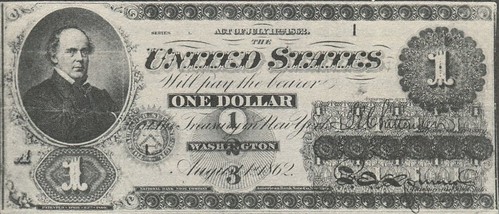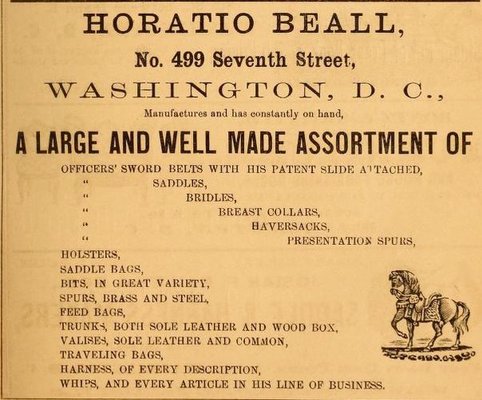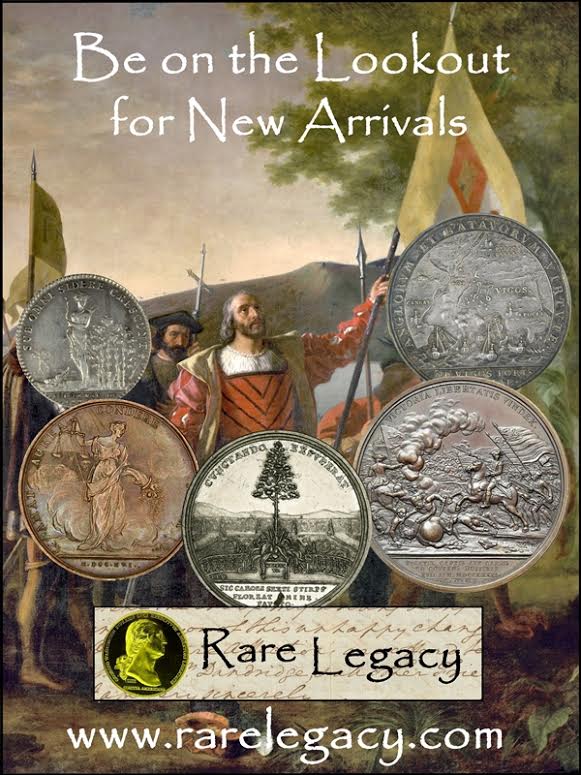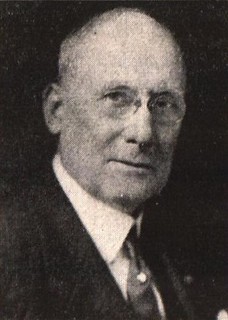
PREV ARTICLE
NEXT ARTICLE
FULL ISSUE
PREV FULL ISSUE
PROVENANCE OF THE VERY FIRST LEGAL TENDER NOTEPeter Huntoon submitted this update on the provenance of the first $1 U.S. Legal Tender Note. Thanks! -Editor
Provenance of the Very First $1 U.S. Legal Tender Note I figured I had run out of leads when I sent an update to E-Sylum concerning the three notes that Salmon P. Chase saved while serving as Lincoln’s Secretary of the Treasury. Through phenomenal good luck, I was wrong. A sensational revelation pertaining to his 1862 $1 legal tender note has emerged. The notes under the glass are the following: • $10 Demand Note, Act of July 17, 1861, serial number 1, plate position A. • $1 Legal Tender Note, Act of July 11, 1862, series 1, serial number 1, plate position A. • $5 National Bank Note, Act of February 25, 1863, Original Series, The First National Bank of Washington, DC, Treasury sheet serial 9, bank sheet serial 1, plate D. As related previously, each of the three represents the first of its kind.  First $1 1862 legal tender note, Series 1, serial 1, plate position A. Photo from Reinfeld (1960, p. 62) that Reinfield obtained from the Chase Manhattan Bank collection. Chase served as Lincoln’s Secretary of the Treasury during the Civil War between March 7, 1861 and June 30, 1864 and later as Lincoln’s appointee as Chief Justice of the Supreme Court from December 6, 1864 to May 7, 1873. He was the architect of the Treasury’s entry into the currency-issuing business so he was positioned to obtain the first of each. Best of all, in the case of the $1, he had seen to it that his portrait graced the note. We knew that the $1 legal tender had been saved by Chase and carried by him to show off to friends and acquaintances. Its first numismatic appearance was at the hand of George Blake, the renowned turn-of-the-last century currency collector who exhibited the note at the 1914 American Numismatic Association convention in Springfield, Massachusetts. Blake happened to have been born in Springfield in 1858, although at the time of the 1914 convention he was long a resident of Jersey City, NJ. You might be interested to know that the convention was held August 22-26 in the White and Gold Hall of the Municipal Auditorium, whereas the business session was held in the magnificent Mahogany Room of the same building. The official headquarters hotel was the Hotel Kimball, which “is the largest, most modern, and only absolutely fire-proof hotel in Springfield.” A suite of rooms was reserved for attendees as follows: rooms with running water and free use of bath $1.50 for one person per night or $2.50 for two. Not good enough, then reach for a suite with parlor, chamber and bath at $5.50 for one person per night or $9 for two. And by the way, “The roads throughout the New England States are of unexcelled quality, and those planning to go to the convention by motor should not hesitate to do so, as a tour through the beautiful scenery of New England is one not to be missed.” The $1 ended up in the Chase Manhattan Bank collection in New York City. I surmised that Blake sold it to the bank, but from there I lost track of it because it did not arrive at the National Numismatic Collection in the Smithsonian Institution when the bank donated its paper money collection to the nation. Joe Sande caught me at the 2017 International Paper Money Show at Kansas City and advised that the Chase Bank still has the ace and it now resides in a small collection of historic treasures that is in their corporate offices in New York. It is in an exhibit that is not accessible to the public that also includes the Hamilton-Burr dueling pistols, among other high-power objects. Of course, retaining ownership of the note by the bank made all the sense in the world. The first U. S. $1 note complete with Chase’s portrait goes straight to the very heart of the corporate identity of the bank. I should have anticipated that. Luminary numismatic researcher Gene Hessler, author of U. S. Essay, Proof and Specimen Notes; The Engraver’s Line; An Illustrated History of U.S. Loans; The International Engraver’s Line as well as the Comprehensive Catalog of U. S. Paper Money, e-mailed me after he read my update with information that simply knocked my socks off. Gene served as curator of the Chase Money Museum from 1967 to 1977. He was involved in the decision that led to the retention of the note by the bank in 1977. Gene was prescient enough to save a photocopy of the most important document in existence that fleshes out the pedigree of the note. Feast your eyes on the content of a memo written and signed by George Blake in 1916 that tells how the note got from Chase to him. New York, May 9, 1916 Statement of ownership of the very first one dollar note issued by the United States This note bears the portrait of the late Hon. Salmon P. Chase, Secretary of the Treasury, and formerly Governor of Ohio, and was issued to him in August or September 1862. Some time later Mr. Chase presented it to Horatio Beall, who came also, I believe, from Ohio. From Mr. Beall it passed to his daughter Alice, afterwards Mrs. Will, who is now a widow living in Chevy Chase, Maryland. Mrs. Will retained the note until it was purchased by me in the year 1914. (signed) George H. Blake A numismatic paper trail doesn’t get more definitive than this! Who was Horatio Beall? He was a manufacturer and purveyor of equestrian supplies, leather goods and related items in Washington, DC, during the period when Chase was in government there. Shown is Beall’s advertisement from the 1864 Washington City Directory. Beall died March 27, 1865 on the eve of his 44th birthday. His daughter Alice died in 1933 at age 83. One discrepancy in Blake’s writeup is that it says Beall was from Ohio. In fact, he was a native of Georgetown/Washington, DC. We don’t know the relationship between the men; that is, whether it was simply professional or also had a social dimension. You wonder how the topic of Chase’s $1 bill came up and the exchange was perfected. But, at least we know that it happened so that the previous time gap in the story is nicely covered! Of the three notes Chase is known to have owned, this is the only one for which we know the entire pedigree. George Blake was in the sole leather and belting business for 47 years. For 44 years, he served as the secretary and treasurer of the National Association of Leather Belting Manufactures. His proximity to New York City and his gentlemanly demeanor allowed him to cultivate bankers there and elsewhere in the country in his quest for large and small size U. S. type notes. At the time, he was the foremost ferret who acquired and sold a significant percentage of the low and fancy serial numbered large and small notes that were saved from his era. Notes attributed to him populate the large size type note listings in the Gengerke census.  His greatest claim to numismatic fame was that he encouraged Col. Edward Green, Hetty Green’s son, to collect serial number 1 Series of 1929 sheets. He then served as the fellow who contacted the bankers across the country in order to assemble that enormous trove on a commission basis for Green. This effort turned out to be a retirement project for him and served as the ultimate source for most of the number 1 1929 nationals that are in numismatic hands.
Blake’s scholarly legacy included publishing United States Paper Money including Fractional Currency, also the Coinage of all United States Mints since their Organization in 1908, which was the first organized listing of U. S. paper money and coins. His research comprised the core of Frank Limpert’s catalog United States Paper Money, Old Series, 1861-1923, first published in 1949, where he is acknowledged as a collaborator. He also served the ANA as its Treasurer from 1922 to 1949, after having been on its board of directors. He was posthumously inducted into the ANA Hall of Fame in 1970. Beall, Horatio, https://www.ourfamtree.org/view.php?pid=270036&aid=31078 Erlanger, Herbert J., March 1951, Medals of the New York Numismatic Club, George H. Blake: The Numismatist, p. 271-272. Gengerke, Martin T., on demand, U. S. paper money records, a census of U. S. large size type notes: CD produced on order, gengerke@aol.com. The Numismatist, July 1914, The Springfield Convention, Aug. 22-26, 1914: p. 339-340. The Numismatist, February 1956, Obituaries, George H. Blake, LM 150: p. 166. Reinfeld, Fred, 1960, A simplified guide to collecting American paper money: Hanover House, Garden City, NY, 128 p. Smith, Pete, 1992, American Numismatic Biographies, Blake, George H.: Gold Leaf Press, Rocky River, OH, p. 31. To read the earlier E-Sylum article, see:  Wayne Homren, Editor The Numismatic Bibliomania Society is a non-profit organization promoting numismatic literature. See our web site at coinbooks.org. To submit items for publication in The E-Sylum, write to the Editor at this address: whomren@gmail.com To subscribe go to: https://my.binhost.com/lists/listinfo/esylum All Rights Reserved. NBS Home Page Contact the NBS webmaster 
|
